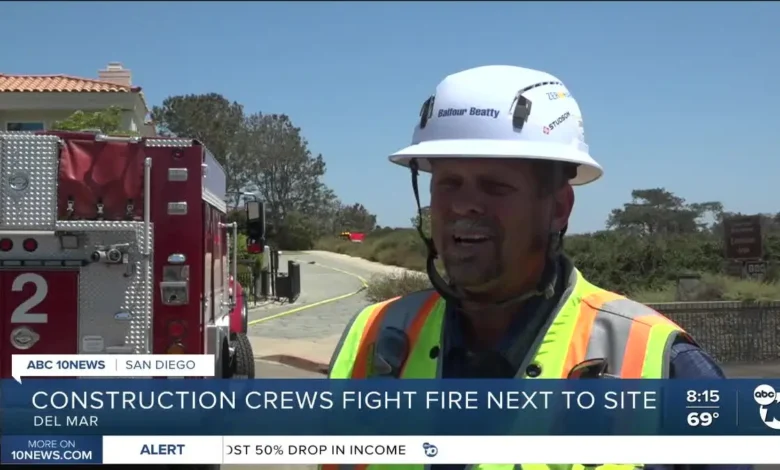Del Mar Fire: A Community’s Battle Against Flames

Introduction to the Del Mar Fire
Del Mar, known for its beautiful beaches and coastal charm, faced a serious threat when the Del Mar fire erupted. The fire reminded residents that even paradise is not immune to natural disasters. Nestled along the coast of Southern California, Del Mar is often considered a tranquil place where people go to escape the hustle of city life. However, the fire that swept through the area shook the community, exposing vulnerabilities that many hadn’t considered.
Fires are a constant danger in many parts of California, but a fire of this magnitude for Del Mar was rare. This event tested the community’s preparedness and resilience in ways they hadn’t imagined. Though not as catastrophic as some of California’s more enormous wildfires, the Del Mar fire still left its mark on the region. From the damage to homes and property to the emotional toll on the residents, the Del Mar fire became a significant event in the town’s history.
The fire also shed light on the growing risks of wildfires in coastal areas, which are often overlooked. As the climate changes and drought conditions worsen, even coastal cities like Del Mar are not safe from the dangers of wildfires. The Del Mar fire is a reminder that fire safety and preparedness are critical for everyone, regardless of location.
Causes of the Del Mar Fire
Various factors can spark wildfires, and the Del Mar fire was no different. Like many fires in California, the Del Mar fire’s causes were traced back to environmental conditions and human activity. Understanding the causes of wildfires is critical to preventing them in the future, and the Del Mar fire offered several lessons in this regard.
One of the primary factors contributing to the Del Mar fire was the extreme drought conditions that had plagued the region for months leading up to the blaze. California’s prolonged dry spells create the perfect conditions for wildfires to ignite. In Del Mar, the typically lush coastal vegetation had become brittle and dry, turning it into fuel for the fire. Combined with the strong winds that often sweep through the area, these dry conditions allowed the fire to spread quickly.
While environmental conditions were a significant factor, human activity also played a role. Though unintentional, the spark that started the Del Mar fire was believed to be linked to negligence, such as improper disposal of flammable materials or electrical issues. Unfortunately, fires caused by human error are common, and the Del Mar fire is a stark reminder of how easily a tiny mistake can lead to a large-scale disaster.
The Rapid Spread and Devastation of the Fire
Once ignited, the Del Mar fire spread alarmingly, fanned by strong winds coming off the coast. The dry brush and vegetation provided ample fuel for the flames, allowing the fire to move quickly across the landscape. This rapid spread caught many residents off guard as they watched the fire advance toward their homes and neighborhoods with little time to react.
The fire consumed acres of land, including residential properties and natural landscapes that Del Mar residents cherished. The devastation left behind was hard to fathom, as homes were reduced to ashes and trees that had stood for decades were gone in an instant. While the physical damage was significant, the emotional toll on the community was even more critical. For many, seeing their town engulfed in flames was a surreal and terrifying experience.
In addition to destroying property, the fire posed a severe threat to local wildlife. Del Mar’s coastal environment is home to various species, many displaced or killed by the fire. The ecological damage caused by the fire will take years to recover, as the area’s delicate ecosystem was severely disrupted.
Evacuations and the Community Response

As the Del Mar fire spread, local authorities quickly issued evacuation orders, urging residents to leave their homes and seek safety. Evacuations during a wildfire are always stressful and chaotic, and the Del Mar fire was no exception. Many residents had only minutes to gather their belongings and evacuate, leaving behind homes and possessions they had worked their whole lives for.
Despite the chaos, the Del Mar community showed incredible resilience and cooperation. Neighbors helped each other evacuate, offering rides and assistance to those in need. Local shelters were quickly set up to provide refuge for evacuees, and volunteers from the surrounding areas offered their time and resources to support those displaced by the fire.
The community response was a testament to the strength and solidarity of the people of Del Mar. In the face of disaster, they came together to support one another, demonstrating that even in the worst times, the human spirit is capable of great compassion and kindness. This sense of community was crucial in helping residents cope with the emotional and physical toll of the fire.
The Role of Firefighters and Emergency Services
The Del Mar fire would have caused far more damage if not for the heroic efforts of the firefighters and emergency services personnel who worked tirelessly to contain the blaze. Firefighters across the region were deployed to Del Mar, battling the flames in dangerous conditions and working around the clock to protect homes and lives.
Fighting a wildfire is a complex and hazardous task, particularly in challenging terrain like Del Mar. The rugged coastal cliffs and dry brush made it difficult for ground crews to reach certain areas. Still, firefighters used every tool, including aerial water drops and fire retardant, to slow the fire’s advance.
The bravery and dedication of these firefighters cannot be overstated. Many of them risked their own lives to ensure the safety of others, often working in extreme heat and dangerous conditions to keep the fire from spreading further. Their efforts undoubtedly saved countless homes and lives, and the people of Del Mar will forever be grateful for their service.
The Impact on Local Wildlife and Natural Landscapes
The Del Mar fire affected the human population and significantly impacted the local wildlife and natural landscapes. Del Mar’s coastal environment is home to a diverse range of species, many of which were displaced or lost their habitats as a result of the fire. The destruction of these habitats reminds us of wildfires’ far-reaching consequences on ecosystems.
Wildfires can drastically alter the landscape, leaving behind charred earth and destroyed vegetation. In Del Mar, the fire consumed much of the native plant life, whichntial for maintaining the region’s ecological balance. The loss of these plants affects the wildlife that relies on them for food and shelter and increases the risk of soil erosion, which can lead to further environmental degradation in the future.
The recovery of the natural landscape will take time, and while some species may return as the area regenerates, others may be less fortunate. The Del Mar fire reminds us of the delicate balance between human development and nature and the need for continued efforts to protect and preserve the environment in the face of increasing wildfire risks.
The Role of Technology in Combating Wildfires
Technological advancements have recently played a crucial role in the fight against wildfires, and the Del Mar fire was no exception. From real-time data tracking to aerial surveillance, technology has become an invaluable tool for firefighters and emergency responders working to contain fires and protect communities.
One of the most significant technological advancements in firefighting is using drones equipped with thermal imaging cameras. These drones provide real-time data on the fire’s movement, allowing firefighters to decide where to deploy resources. During the Del Mar fire, drones were used extensively to monitor the fire’s progress and identify hot spots that required immediate attention.
Aerial firefighting equipment, such as helicopters and planes, also played a critical role in combating the Del Mar fire. These aircraft dropped water and fire retardant on the flames, helping slow the fire’s advance and protect homes and businesses. The use of aerial resources was crucial in reaching areas difficult for ground crews, such as the rugged coastal cliffs and canyons.
Recovery and Rebuilding After the Del Mar Fire
Once the flames were extinguished, the long and challenging recovery and rebuilding process began. The Del Mar fire left behind a trail of destruction, with many homes, businesses, and natural landscapes reduced to ashes. For the residents who lost their homes, the road to recovery was both emotional and practical as they worked to rebuild their lives in the aftermath of the fire.
Rebuilding after a wildfire is a complex and time-consuming process. Many residents faced challenges with insurance claims, permits, and the logistics of rebuilding in a fire-prone area. The emotional toll of losing a home also weighed heavily on those affected, as they struggled to come to terms with their loss while trying to move forward.
Local and state agencies worked to provide support and resources to those affected by the fire, offering financial assistance, temporary housing, and guidance on the rebuilding process. Community organizations also played a vital role in helping residents recover, organizing fundraisers and donation drives to support those in need.
Despite the challenges, the resilience of the Del Mar community shone through as residents began rebuilding their homes and lives. The fire may have left scars on the landscape, but the spirit of the community remained strong, and the people of Del Mar proved that they could overcome even the most difficult of circumstances.
The Long-Term Environmental Impact
While the immediate aftermath of the Del Mar fire focused on the destruction of homes and property, the long-term environmental impact of the fire must be addressed. Wildfires have a lasting effect on the landscape, and it will take years for the area to recover from the damage caused by the flames entirely.
One of the most significant environmental concerns after a wildfire is the risk of soil erosion. The fire destroyed much of the vegetation that helps hold the soil in place, leaving the ground vulnerable to erosion during rainstorms. This erosion can lead to further environmental damage, as sediment is washed into local waterways, affecting water quality and disrupting aquatic ecosystems.
The loss of vegetation also impacts the local wildlife, as many species rely on it.





